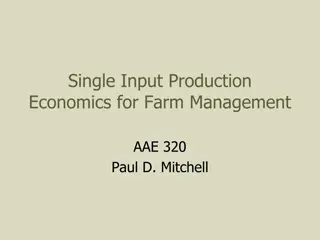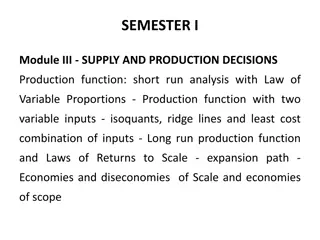Understanding Input-Output Models in Economics
Input-Output models, pioneered by Wassily Leontief, depict inter-industry relationships within an economy. These models analyze the dependencies between different sectors and have been utilized for studying agricultural production distribution, economic development planning, and impact analysis of investments. Geographers find input-output models useful for exploring interactions on Earth's surface, despite challenges related to data availability and complexity. These models offer insights into the interconnections among sectors and help in understanding economic linkages at regional and inter-regional levels.
- Input-Output Models
- Economic Analysis
- Wassily Leontief
- Inter-Industry Relationships
- Geographical Interactions
Uploaded on Apr 07, 2024 | 8 Views
Download Presentation

Please find below an Image/Link to download the presentation.
The content on the website is provided AS IS for your information and personal use only. It may not be sold, licensed, or shared on other websites without obtaining consent from the author. Download presentation by click this link. If you encounter any issues during the download, it is possible that the publisher has removed the file from their server.
E N D
Presentation Transcript
Input Input- -Output Models Output Models
Input-Output model is a quantitative economic model that represents the interdependencies between different sectors of a national economy or different regional economies. Wassily Leontief (1906-1999) is credited with developing this type of analysis and earned the Nobel Prize in Economics for his development of this model. The model depicts inter-industry relationships within an economy, showing how output from one industrial sector may become an input to another industrial sector. In the inter-industry matrix, column entries typically represent outputs from a given sector. This format therefore shows how dependent each sector is on every other sector, both as a customer of outputs from other sectors and as a supplier of inputs.
Input Input- -Output These models have been used for the comprehension of the distribution of agricultural production by Peterson and Heady (1956), and Carter and Heady (1959). They have used these models to analyse the interrelationships and the degree of interdependence among the various regional and commodity sectors of agriculture and the effect of policy changes on the patterns of agricultural production. More recent studies based on input-output analysis are that of Jasbir Singh et al (1985) who identified the changes in agricultural productivity as effected by various inputs as well as by interrelationships and the degree of interdependence among them. Output Models Models in in Agricultural Agricultural Geography Geography
If geographers are genuinely interested in the analysis of interactions on the face of the earth, then input-output models are the possible tools which they can usefully employ. It has been observed that a major attribute of these models is that they provide a detailed description of interrelationships and linkages between the output and the various input elements. In practice the level of details may be restricted by scanty data. This handicap can be overcome by undertaking such studies with the help of a primary source of data i.e., the collection of data at the operational holding level. On the whole, these models are very generalized and are difficult to operate because of the wide range of input data required.
To sum up, the input-output models explicitly recognize that changes in production in one sector inevitably affect production in many other sectors as well, because of changed demands for outputs for other sectors and a corresponding variation in the inputs in these sectors. These models have proved very useful in the tasks of studying the impact of the determinants of the attributes, planning economic development, and analysing the locational implications of economic development in a region. Besides, they are particularly valuable for determining the impact of increased investment in one region or sector on the economic activity in others. Therefore, these models may be classified as regional and inter-regional input- output models.























